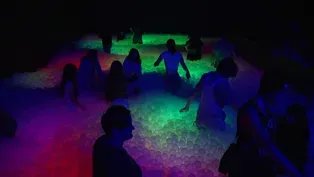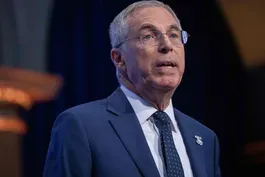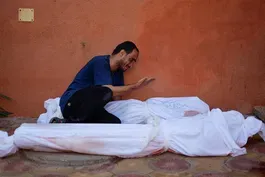
How 'lab-grown' meat is made and will people accept it?
Clip: 12/27/2023 | 7m 18sVideo has Closed Captions
How 'lab-grown' meat is made and will people accept it?
The Department of Agriculture recently approved the production of what’s known as cultivated meat, which is chicken grown in a lab. That approval clears the way for companies to begin selling poultry produced from animal cells rather than animals bred in factory farms and killed. But the industry still faces hurdles before Americans see it in their grocery stores. William Brangham reports.
Problems with Closed Captions? Closed Captioning Feedback
Problems with Closed Captions? Closed Captioning Feedback
Major corporate funding for the PBS News Hour is provided by BDO, BNSF, Consumer Cellular, American Cruise Lines, and Raymond James. Funding for the PBS NewsHour Weekend is provided by...

How 'lab-grown' meat is made and will people accept it?
Clip: 12/27/2023 | 7m 18sVideo has Closed Captions
The Department of Agriculture recently approved the production of what’s known as cultivated meat, which is chicken grown in a lab. That approval clears the way for companies to begin selling poultry produced from animal cells rather than animals bred in factory farms and killed. But the industry still faces hurdles before Americans see it in their grocery stores. William Brangham reports.
Problems with Closed Captions? Closed Captioning Feedback
How to Watch PBS News Hour
PBS News Hour is available to stream on pbs.org and the free PBS App, available on iPhone, Apple TV, Android TV, Android smartphones, Amazon Fire TV, Amazon Fire Tablet, Roku, Samsung Smart TV, and Vizio.
Providing Support for PBS.org
Learn Moreabout PBS online sponsorshipearlier this year the Agriculture# Department approved the production## of what's known as cultivated meat.# That is chicken grown in a lab.
That approval clears the way for# companies to begin selling poultry## produced from animal cells, rather than# animals bred in factory farms Wi lliam Brangham gives us a taste of# what the future could hold.
William NATE PARK, Chef, Good Meat: We# put a little allium glaze on it,## which is just an onion-garli WILLIAM BRANGHAM: At the Good Meat plant# in Alameda, California, chef Nate Park is## putting the finishing touches on a dish that is# seemingly pulled right out of science fiction.
NATE PARK: A lot of people don't know what# this is.
So there's a tendency to maybe back## away because they don't know what it is.
But# I think once they understand wh that it's just chicken, and that it's delicious,# it'll be very easy for everyone WI LLIAM BRANGHAM: Getting people comfortable with# the idea of cultivated chicken is at the heart of## operations here at Good Meat.
It's one of two# companies now federally approved to make it.
NATE PARK: We want to slice it in front of you.## We want you to see what it is that# WI LLIAM BRANGHAM: Grilled, sliced and served# with heirloom beans and a sw If you had said nothing about this, I# would just think this was a lovely meal.
NATE PARK: Well, thank you.
WILLIAM BRANGHAM: It taste NATE PARK: It's chicken.
WILLIAM BRANGHAM: And delicious.
NATE PARK: WILLIAM BRANGHAM: But be seen here, inside this bioprocessing# lab, as tiny microscopic stem cells.
They're all taken from real chickens without# harming them.
The cells are then constantly## stirred, kept warm, and nourished, so that they# will multiply inside these massive bioreactors.
It's all part of a lengthy process# designed to mirror how actual animals grow.
JOSH TETRICK, CEO, Eat Just: Cultivated meat# has been talked about for over 100 years.
WILLIAM BRANGHAM: Josh Tetrick is the co-founder# and CEO of Eat Just, which op What is the rationale for cultivated meat?
JOSH TETRICK: First and foremost, we just got# to accept people love meat.
An really difficult, to get people to# stop eating meat and choose beans## or some other plant-based source,# which would be better for them.
So how do you get at that?
And# I think the answer is,you make## real meat in exactly the same taste# and texture that people are used t but you make it in a way that doesn't require# billions of animals.
You just can't feed## the world without the billions of animals,# because each animal has to be slaughtered.
WILLIAM BRANGHAM: Global food production# is responsible for roughly a third of all## the manmade greenhouse gases that are# dangerously heating the planet.
And## meat production is the major driver of# that impact, with the majority of the## world's croplands and forests being used# to grow food for the animals we then eat.
JOSH TETRICK: If were going to solve the# climate problem, we definitely need to move## from fossil fuels to renewable energy.
And we# also definitely need to mo animal farming that is eating up a third of our# planet today to an entirely different approach.
WILLIAM BRANGHAM: But not everyone# is sold on this new approach.
NED SPANG, University of California,# Davis: We can't just take it as a that cultured meat is good for the environment.
WILLIAM BRANGHAM: Ned Spang is an associate# Da vis, who studies the links# between food and the environment.
He says, while no animals are# being slaughtered, a recent report## he co-authored about cultured meat indicates# it's not nearly as green as many would hope.
NED SPANG: Along the lines of climate# emissions or energy use, we found that## cultivated meat might actually have more of# an impact than the conventional agriculture.
WILLIAM BRANGHAM: And how is that possible?
NED SPANG: Well, the major driver is# that these are still ani so they still need to eat food.
And, basically,## just as a cow needs to eat some grass or corn# to grow and grow muscle ma the cells.
And so we need to feed them glucose# for energy and amino acids to build proteins.
And it takes a lot of resources to actually make## the food to grow these cells# to create the cultiv WILLIAM BRANGHAM: But Tetrick argues that, as# the technology improves, cultivated meat the potential to pollute much less and consume# far less land and water than conventional meat.
And he argues, our current approach,## from its cruelty to animals to its# environmental impacts, has JOSH TETRICK: We're eating food# every day that no one would be## proud of if they actually engaged with it.
WILLIAM BRANGHAM: Several companies have come# to market with plant-based meat substitutes,## like Beyond Meat or Impossible Burgers.
But cultivated meat will likely be a tougher# sell.
A recent poll from the As found that half of adults in the U.S.# say they would be unlikely to try it,## with many citing that it sounded weird.
JOSH TETRICK: We found the most# effective way this is kind of weird to, all right,# I'm down with it, is put it on a plate,## get them hanging out with their friends# and have them eat the chicken.
And then## a bit about midway through it, they're# like, all right, this is just chicken.
WILLIAM BRANGHAM: So far, only a few# restaurants in the U.S. ha served cultivated chicken, including# China Chilcano in Washington, D.C. WILLIAM BRANGHAM: Take it right like this?
DANIEL LUGO, H WILLIAM BRANGHAM: That is delicious.
It's owned by world-famous# chef head chef Daniel Lugo prepares it as# a traditional Peruvian street food.
So when Jose first came to you and said,## we'd like to try cooking with this u DANIEL LUGO: Well, at first, I was# super excited and curious.
And,## to be honest, once I tried it, I was# super surprised and actually liked it.
WILLIAM BRANGHAM: But getting cultivated meat both## into more restaurants and eventually Good Meat is reportedly looking for# ways to cut surging production costs.## The company had aimed to eventually produce# up to 30 million pounds of meat annually.
JOSH TETRICK: Yes, we are nowhere# near the scalability to actually## make a dent in this problem.
And that was# exactly the sa years ago.
And we were in exactly the same# position for electric cars 20 years ago.
And if you're ultimately going to# shift the system, best to start now,## because it's going to be a many-many-decade long,# very, very hard, uncertain problem to solve.
WILLIAM BRANGHAM: It's a problem now being# tested and tasted in labs like this one.
For the "PBS NewsHour," I'm William# Brangham in Alameda, California.
Hostage affairs envoy on efforts to free detained Americans
Video has Closed Captions
Clip: 12/27/2023 | 6m 53s | Envoy for hostage affairs describes efforts to free Americans detained abroad (6m 53s)
Immersive exhibitions change the way people consume art
Video has Closed Captions
Clip: 12/27/2023 | 6m 23s | Immersive exhibitions are changing the way people consume art (6m 23s)
Israeli ambassador to U.S. on war tactics, future of Gaza
Video has Closed Captions
Clip: 12/27/2023 | 10m 27s | Israeli ambassador to U.S. discusses strategy, war tactics and future of Gaza (10m 27s)
Israel shows no sign of slowing down strikes in Gaza
Video has Closed Captions
Clip: 12/27/2023 | 3m 17s | Israel shows no sign of slowing down, launching new strikes in central and southern Gaza (3m 17s)
U.S. asks Mexico to help stop migrants from reaching border
Video has Closed Captions
Clip: 12/27/2023 | 8m 38s | White House wants Mexico to make it harder for migrants to reach U.S. border (8m 38s)
Why congregations are leaving the United Methodist Church
Video has Closed Captions
Clip: 12/27/2023 | 5m 9s | Why thousands of congregations are leaving the United Methodist Church (5m 9s)
Providing Support for PBS.org
Learn Moreabout PBS online sponsorshipSupport for PBS provided by:
Major corporate funding for the PBS News Hour is provided by BDO, BNSF, Consumer Cellular, American Cruise Lines, and Raymond James. Funding for the PBS NewsHour Weekend is provided by...

















